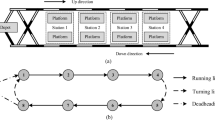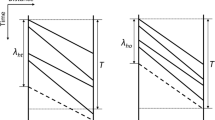Abstract
After major capacity breakdown(s) on a railway network, train dispatchers need to generate appropriate dispatching plans to recover the impacted train schedule from perturbations and minimize the expected total train delay time under stochastic scenarios. In this paper, we propose a cumulative flow variables-based integer programming model for dispatching trains under a stochastic environment on a general railway network. Stable Train Routing (STR) constraints are introduced to ensure that trains traverse on the same route across different capacity breakdown scenarios, which are further reformulated to equivalent linear inequality constraints. Track occupancy and safety headways are modelled as side constraints which are dualized through a proposed Lagrangian relaxation solution framework. The original complex train dispatching problem is then decomposed to a set of single-train and single-scenario optimization subproblems. For each subproblem, a standard label correcting algorithm is embedded for finding the time dependent least cost path on a space-time network. The resulting dual solutions can be transformed to feasible solutions through priority rules. Numerical experiments are conducted to demonstrate the efficiency and effectiveness of the proposed solution approach.













Similar content being viewed by others
References
Adenso-Diaz B, Oliva González M, González-Torre P (1999) On-line timetable rescheduling in regional train services. Transp Res B 33(6):387–398
Albrecht T (2009) The influence of anticipating train driving on the dispatching process in railway conflict situations. Netw Spat Econ 9(1):85–101
Brännlund U, Lindberg PO, Nõu A, Nilsson J-E (1998) Railway timetabling using Lagrangian relaxation. Transp Sci 32(4):358–369
Cacchiani V, Huisman D, Kidd M, Kroon L, Toth P, Veelenturf L, Wagenaar J (2014) An overview of recovery models and algorithms for real-time railway rescheduling. Transp Res B 63:15–37
Caprara A, Fischetti M, Toth P (2002) Modeling and solving the train timetabling problem. Oper Res 50(5):851–861
Caprara A, Monaci M, Toth P, Guida PL (2006) A Lagrangian heuristic algorithm for a real-world train timetabling problem. Discret Appl Math 154(5):738–753
Carey M, Crawford I (2007) Scheduling trains on a network of busy complex stations. Transp Res B 41(2):159–178
Corman F, D’Ariano A, Pacciarelli D, Pranzo M (2012) Bi-objective conflict detection and resolution in railway traffic management. Transp Res C 20(1):79–94
Corman F, D’Ariano A, Hansen IA, Pacciarelli D (2011) Optimal multi-class rescheduling of railway traffic. J Rail Transp Plan Manag 1(1):14–24
Corman F, D’Ariano A, Pacciarelli D, Pranzo M (2009) Evaluation of green wave policy in real-time railway traffic management. Transp Res C 17(6):607–616
D’Ariano A, Corman F, Pacciarelli D, Pranzo M (2008) Reordering and local rerouting strategies to manage train traffic in real time. Transp Sci 42(4):405–419
D’Ariano A, Pranzo M (2009) An advanced real-time train dispatching system for minimizing the propagation of delays in a dispatching area under severe disturbances. Netw Spat Econ 9(1):63–84
D’Ariano A (2009) Innovative decision support system for railway traffic control. Intell Transp Syst Mag 1(4):8–16
Hansen IA (2010) Railway network timetabling and dynamic traffic management. Int J Civ Eng 8(1):19–32
INFORMS RAS (2012) Problem description and released data set for problem solving competition- 2012. http://www.informs.org/Community/RAS/Problem-Solving-Competition/2012-RAS-Problem-Solving-Competition
Iqbal SMZ, Grahn H, Törnquist J et al (2013) Multi-strategy based train re-scheduling during railway traffic disturbances. Proceedings of the 5th international seminar on rail operations modeling and analysis (RailCopenhagen 2013, pp. 387-405). Technical University of Denmark, Denmark
Krueger H, Vaillancourt E, Drummie AM, Vucko, SJ, Bekavac J (2000) Simulation within the railway environment. Proceedings of the 2000 winter simulation conference, 1191-1200
Larsen R, Pranzo M, D’Ariano A, Corman A, Pacciarelli D (2014) Susceptibility of optimal train schedules to stochastic disturbances of process times. Flex Serv Manuf J 26(4):466–489
Lamorgese L, Mannino C (2012) An exact decomposition approach for the real-time train dispatching problem. Technical report N. A23274, SINTEF ICT, Norway, to appear in operations research
Luethi M, Medeossi G, Nash A (2009) Structure and simulation evaluation of an integrated real-time rescheduling and train control system for railway networks. Netw Spat Econ 9(1):103–121
Lusby R, Larsen J, Ehrgott M, Ryan D (2013) A set packing inspired method for real-time junction train routing. Comput Oper Res 40(3):713–724
Meng L, Zhou X (2011) Robust single-track train dispatching model under a dynamic and stochastic environment: a scenario-based rolling horizon solution approach. Transp Res B 45(7):1080–1102
Meng L, Zhou X (2014) Simultaneous train rerouting and rescheduling on an N-track network: a cumulative flow count based model reformulation. Transp Res B 67:208–234
Mu S, Dessouky M (2011) Scheduling freight trains traveling on complex networks. Transp Res B 45(7):1103–1123
Pachl J (2009) Railway operation and control, 2nd edn. VTD Rail Publishing, Mountlake Terrace, ISBN: 978-0-9719915-8-3
Pellegrini P, Marlière G, Rodriguez J (2014) Optimal train routing and scheduling for managing traffic perturbations in complex junctions. Transp Res B 59:58–80
Quaglietta E, Corman F, Goverde RMP (2013) Stability of railway dispatching solutions under a stochastic and dynamic environment. J Rail Transp Plan Manag 3(4):137–149
Schachtebeck M, Schöbel A (2010) To wait or not to wait-and who goes first? Delay management with priority decisions. Transp Sci 44(3):307–321
Sun H, Gao Z, Szeto WY, Long J, Zhao F (2014) A distributionally robust joint chance constrained optimization model for the dynamic network design problem under demand uncertainty. Netw Spat Econ 14(3-4):409–433
Tarhini H, Bish DR (2015) Routing strategies under demand uncertainty. Netw Spat Econ. doi:10.1007/s11067-015-9293-7, Online First
Törnquist J (2005) Computer-based decision support for railway traffic scheduling and dispatching: a review of models and algorithms. Proceedings of ATMOS2005 (Algorithmic methods and models for optimization of railways), Mallorca, Spain
Törnquist J, Persson J (2007) N-track rail traffic re-scheduling during disturbances. Transp Res B 41(3):342–362
Yaghini M, Sarmadi M, Nikoo N, Momeni M (2014) Capacity consumption analysis using heuristic solution method for under construction railway routes. Netw Spat Econ 14(3-4):317–333
Yang L, Zhou X (2014) Constraint reformulation and a Lagrangian relaxation-based solution algorithm for a least expected time path problem. Transp Res B 59(1):22–44
Yoko T, Tomii N (2005) Robustness indices for train rescheduling. Proceedings of the 1st international seminar on railway operations modeling and analysis (RailDelft 2005), June 08-10. Delft University of Technology, Delft
Acknowledgments
The work of the first and second authors was jointly supported by National Natural Science Foundation of China (No. 71201009), State Key Laboratory of Rail Traffic Control and Safety, Beijing Jiaotong University (No. RCS2013ZZ001) and the Fundamental Research Funds for the Central Universities (contract No. 2013JBM146, 2014JBZ008, 2014JBM148). The authors are of course responsible for all results and opinions expressed in this paper. Moreover, the authors declare that there is no conflict of interests regarding the publication of this paper.
Author information
Authors and Affiliations
Corresponding author
Rights and permissions
About this article
Cite this article
Meng, L., Luan, X. & Zhou, X. A Train Dispatching Model Under a Stochastic Environment: Stable Train Routing Constraints and Reformulation. Netw Spat Econ 16, 791–820 (2016). https://doi.org/10.1007/s11067-015-9299-1
Published:
Issue Date:
DOI: https://doi.org/10.1007/s11067-015-9299-1




